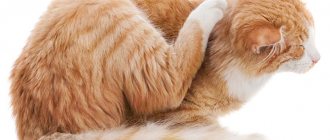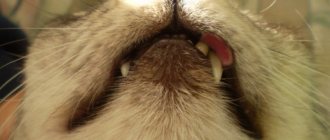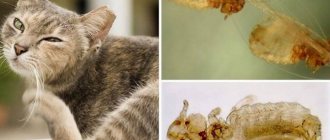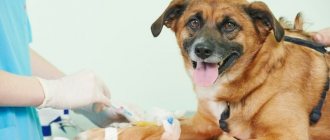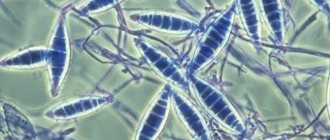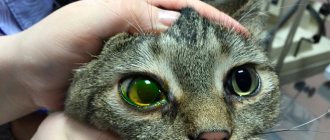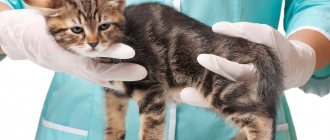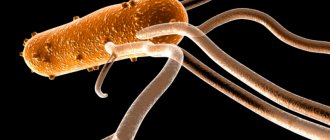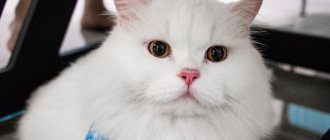12041Administration
Cats are highly mobile, especially when young; when, while playing, they can perform complex tricks, which often end in injury in an apartment. Sometimes even the dog, with whom the cat is friends, can accidentally inflict minor damage during play. A fall from a height usually causes concussions, fractures and bruises of varying severity. If the cat has free access to the street, the risk of injury increases. In such a situation, the owner can easily face the fact that the cat’s paw is bruised. This phenomenon does not pose a danger, but requires proper treatment so that the inflammatory process does not begin. It is also important for owners of four-legged pets to be able to distinguish a simple bruise from more serious injuries, such as fractures and dislocations that require the intervention of a veterinarian.
Causes of the disease
A fracture is a violation of the anatomical integrity of the bone and adjacent tissues. It can be acquired or congenital and occur under the influence of external force or pathology, respectively.
If we talk about congenital pathologies of the bone structure, they are diagnosed in only 1-2% of the total number of visits to veterinary clinics with fractures. The reasons for the birth of kittens with limb fractures are intense labor, osteoporosis, rickets, osteomalacia in the expectant mother.
Veterinarians distinguish two types of acquired bone injuries based on the cause of their occurrence: pathological and traumatic. The first group includes fractures that occurred as a result of osteosarcoma, osteomalacia, etc.
Traumatic fractures occur not only due to various injuries received as a result of falling from a height, being run over by a car, or fighting with an opponent, but also due to unprofessional obstetric care.
Unlike a fracture, a dislocation is a violation of the anatomical location and a change in the physiological functions of the joint. The bone remains intact. Dislocations are also divided into two categories: acquired and congenital. The causes of dislocations are similar to those of fractures.
Not a single animal is insured against acquired dislocations and fractures. Breeds such as Persians, Maine Coons, and Himalayan cats are predisposed to congenital joint pathologies.
Main symptoms
In case of fractures and dislocations, the animal exhibits general clinical signs: pain, impaired motor function (lameness), swelling of the damaged area.
There are three types of fractures: closed, open, and displaced. Serious damage also includes cracks.
Signs of an open fracture in a cat:
- violation of the integrity of the skin;
- the bone is broken, its ends are displaced and protrude;
- tissue rupture in the fracture area;
- bleeding;
- strong pain.
With open wounds, the risks of tissue necrosis and infection are very high.
A closed fracture without displacement is characterized by the following symptoms: the broken bone is in its usual position, the skin and tissues swell, turn blue, and turn red. In a displaced fracture, the bone diverges in different directions, and the soft tissue is partially damaged. There is a danger of internal bleeding.
A crack can easily be confused with a bruise. The bone remains intact, its edges do not diverge and are held in place by the intact area. The cat may move carefully, but it may be in pain.
A simple dislocation is recognized by the following signs:
- skin and tissue remain intact;
- lameness;
- inability to lean on the surface;
- pain when touching the injured limb;
- The dislocated part of the body is asymmetrical.
A complex dislocation, accompanied by rupture of ligaments and tendons, is characterized by the appearance of hematomas in the injured area.
General information about first aid
First aid is the urgent implementation of one or more medical actions necessary in emergency situations. They are undertaken for injured and sick cats immediately on the spot in case of accidents, before the veterinarian arrives.
Therapeutic actions are aimed at improving well-being, removing pain, relieving symptoms of the disease, preventing additional injuries, and reducing the risk of death.
To organize first aid for a cat after being injured, you will need a first aid kit. Therefore, it should be in every apartment where an animal lives.
Diagnostics in a veterinary clinic
The fact that the pet has been injured is immediately obvious, but a visit to the veterinary clinic is necessary. After examining your pet and conducting a series of diagnostic tests, the veterinarian will determine the extent of the damage and prescribe appropriate treatment.
Necessary diagnostic methods include general and biochemical blood tests, x-rays in two projections, and cardiac echocardiography. In some cases, an abdominal ultrasound is required.
Home care
If you have witnessed your cat being hit by a car or falling from a great height and you suspect a fracture, you should put a splint on the injured paw. This procedure will immobilize the broken limb. A flat board can be used as a tire, or, in the absence of one, thick cardboard folded several times.
The splint must be applied in such a way as to be able to fix two joints close to the fracture, below and above. The structure should be wrapped with a bandage in several layers. After this, you need to take the victim to a veterinary clinic.
For open fractures, the wound is closed with sterile gauze, and a splint is applied on top.
If you are sure that your cat has a dislocation, then under no circumstances try to straighten the injured limb yourself! With your inexperienced actions and ignorance of cat anatomy, you can cause irreparable harm to your pet. Apply an ice pack to the affected limb, apply a tight bandage, and take your pet to a veterinarian.
To alleviate the cat’s condition and relieve it from traumatic shock, many owners inject the animal with an anesthetic. However, veterinarians do not recommend doing this at home. Without feeling pain, a cat can cause even more harm to itself.
In addition, analgesics distort the symptoms of injury. Finally, sedation will be required during the X-ray examination, and pre-administration of pain medication will negatively affect the health of the pet.
The animal should be transported to the veterinary clinic lying down in the back seat of the car. The pet should be placed on a horizontal surface - plywood, board, car panel - and secured in the area of the shoulder blades and pelvis with a rope or belt.
The owner’s task is to provide the pet with the most comfortable living conditions during treatment of fractures. A cat's mobility can have a negative impact on its well-being, so freedom of movement should be limited. The ideal option would be to place the animal in a cage for 2-3 weeks.
This design should be quite free, but at the same time not allowing the pet to move a lot. You need to put a tray and bowls of food and water in the cage.
Requirements for organizing first aid
First aid for an injured cat is organized until a veterinarian or animal rescue service arrives. During this time, the life of the animal depends on compliance with the rules of medical procedures, as well as the implementation of therapeutic actions by the owner.
There are two basic requirements for cat emergency care.
Inspection of the accident site
Before you begin first aid, you must carefully inspect the scene of the incident. A visual survey will make it possible to identify additional threats to the life of the animal, the owner himself, and surrounding people.
Increased hazard risks include:
- fire;
- exposed electrical wires;
- heavy traffic flow;
- smoke;
- depth and pollution of the reservoir:
- bad weather conditions;
- evaporation of toxins.
If danger is detected, you should not approach the injured cat. In this case, you need to call the animal rescue service. The rescue squad is equipped with emergency equipment and trained in all first aid skills.
Initial examination
Cats may lose consciousness briefly after being injured. Fainting is not a diagnosis. It is a serious symptom of a pathological disorder of cerebral circulation. To identify the causes of the condition and eliminate it, it is necessary to conduct an initial examination of the cat. Otherwise, minor injuries will lead to his death.
The initial examination of an unconscious animal includes:
- Breathing test. Its presence is indicated by the rising and falling of the chest. Breathing can be noticed visually or felt by placing your hand on the animal’s chest.
- Pulse check. This procedure is carried out in the absence of breathing. The heartbeat is determined by gentle pressure of the hand on the inner thigh.
If it is not possible to detect breathing or a pulse, the cat requires emergency assistance.
Performing an emergency
The complex of emergency medical actions includes artificial ventilation of the lungs with cardiac massage.
Artificial respiration is performed on a cat in the following order:
- The animal is laid on its right side.
- Use your fingers to open the cat's mouth.
- The mouth is cleaned with a handkerchief.
- The owner's mouth is placed on the cat's nose.
- Air is exhaled into the sinuses.
Exhalation is done every 5 seconds. In 1 minute, breathing movements are performed 12 to 15 times. Therapeutic actions are repeated until the cat shows signs of breathing.
In parallel with artificial ventilation, the animal needs to undergo cardiac massage. The procedure for restoring the heartbeat is carried out as follows:
- The owner's thumb rests on the cat's chest.
- The remaining fingers are located on the opposite side of the body.
- Toward the neck, the animal’s chest is sharply compressed with the hand 6 times.
- After contracting the pectoral muscles, the cat exhales once.
These actions alternate with each other until the cat’s heart begins to beat. Then only artificial respiration is performed.
How to treat fractures and dislocations
Simple fractures are treated with conservative methods. These include pain relief and elimination of pain shock. Immobilization using splints and splints is used to restore damaged bone. For pain relief, drugs such as Traumeel and Butomidor are used. Splints and braces are removed only after the veterinarian gives permission to do so.
For complex types of fractures, surgery cannot be avoided. Osteosynthesis involves removing small bone fragments and realigning large ones. Surgical intervention using fixing metal structures should be carried out immediately after diagnosing a fracture.
Pins, plates and spokes made from a special alloy with titanium remain in the animal’s body for life.
After surgery, as well as in cases of open fractures, antibiotic therapy is indicated.
The regeneration process will be helped to speed up by drugs that improve osteosynthesis, vitamin therapy, and physiotherapy.
If a cat has been diagnosed with a dislocation, treatment includes pain relief and realignment of the injured limb, followed by the application of a fixing bandage. In severe cases, surgery is indicated.
As for the prognosis for fractures and dislocations, in most cases it is favorable. The only exceptions are spinal fractures with damage to the spinal cord structure. If the fracture causes rupture of large vessels of the limb or peripheral nerves, then for the cat this ends in the loss of the limb.
Dislocations should not be underestimated: if the damage is not treated, it can subsequently lead to complex muscle deformations and destruction of articular surfaces. As a result, the cat will limp for the rest of its life.
Providing first aid to a cat after injury
Due to their curious temperament, as well as their active lifestyle, cats find themselves in life-threatening situations. Therefore, the owner needs to know how medical measures are carried out. Timely first aid for a cat after an injury is the key to a quick recovery.
Rehabilitation period
How long the recovery phase will last depends on the severity of the fracture, the general condition and age of the cat. In young individuals, it usually lasts three weeks, with a maximum of 30 days. In an old cat, the healing process is longer - 35-40 days.
To monitor proper fusion of the bone structure, your pet should be taken to a veterinary surgeon for a monthly check-up.
In order to restore the motor function of the damaged limb, elasticity and muscle tone, manual massage should be performed, the technique of which will be introduced by the veterinarian. Daily massage procedures stimulate blood circulation, healing of periosseous tissues, and accelerate the process of bone fusion.
A cat's diet should be balanced, nutritious and easily digestible. The animal needs foods enriched with phosphorus and calcium. However, we must remember that an excess of these components often leads to the formation of stones in the gall bladder and kidneys.
Vitamin and mineral supplements will also help speed up your pet's recovery, but they can only be given after consultation with a specialist. The veterinarian prescribes vitamins based on the animal’s needs.
